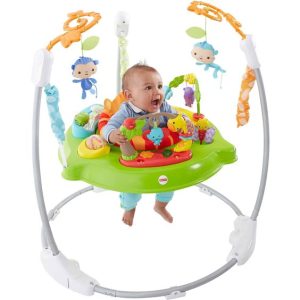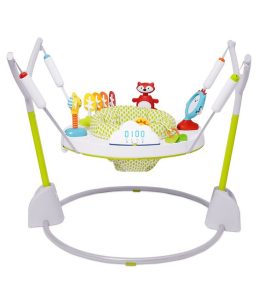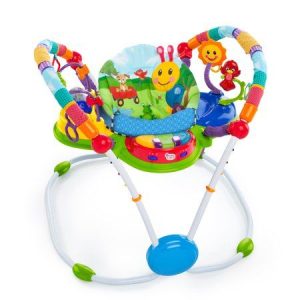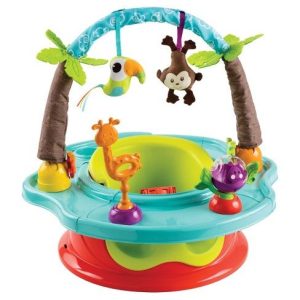Jumpers, also known as baby exercisers, are a common sight in many households. They provide a fun way for babies to bounce and play, but are they actually good for development? This article explores the potential benefits and drawbacks of using jumpers with babies.
Benefits of Jumpers
There are a few potential benefits to using jumpers with babies in moderation.
Entertainment:
Jumpers can be a great source of entertainment for babies. The bouncing motion can be stimulating and engaging, keeping them happy and occupied for short periods.
Strengthening Legs:
Some believe jumpers can help strengthen babies’ legs. The bouncing motion works some leg muscles, though floor play is generally considered more beneficial for overall development.
Improved Balance (with limitations):
In theory, jumpers can help with balance development. However, this is only true if used correctly and for short periods.
It is important to note that these benefits are debated and should be weighed against the potential drawbacks.
Drawbacks of Jumpers
There are several potential drawbacks to consider when using jumpers with babies.
-
Limited Movement: Jumpers restrict a baby’s natural movement patterns. This can hinder their development of important gross motor skills like rolling, crawling, and pulling up.
-
Poor Hip Positioning: Some jumpers can put stress on a baby’s developing hips, especially if their legs are not properly positioned. This can increase the risk of hip dysplasia.
-
Toe Walking: Frequent use of jumpers can encourage toe walking, which can be difficult to break in the future.
-
Safety Concerns: Babies can fall out of jumpers or get their fingers pinched. Always supervise a baby closely while they are in a jumper.
Because of these drawbacks, the American Academy of Pediatrics (AAP) recommends limited use of jumpers.
How to Use Jumpers Safely
If you choose to use a jumper with your baby, here are some safety tips:
- Age and Development: Wait until your baby has good head and neck control and can support some of their weight on their legs before using a jumper.
- Time Limits: Limit jumper use to short bursts, no more than 15 minutes at a time, a few times a day.
- Proper Fit: Ensure the jumper fits your baby securely and their feet can touch the floor flat.
- Constant Supervision: Never leave a baby unattended in a jumper.
Remember, floor play is the best way for babies to develop their gross motor skills.
Alternatives to Jumpers
There are many safe and developmentally appropriate ways for babies to play and exercise. Here are a few alternatives to jumpers:
- Tummy Time: Supervised tummy time on a play mat strengthens neck and back muscles and prepares babies for crawling.
- Floor Play: Provide your baby with plenty of space to roll, crawl, and explore their surroundings. Offer safe toys that encourage them to reach, grasp, and move their bodies.
- Excersaucers: These stationary activity centers allow babies to spin, bounce, and play with toys, but they don’t restrict movement like jumpers.
These alternatives allow babies to develop their natural movement patterns at their own pace.
Jumpers can be a fun way to entertain babies, but they should be used sparingly and with caution. There are potential drawbacks to consider, such as limited movement and improper hip positioning.
Floor play is the best way for babies to develop their gross motor skills. If you do choose to use a jumper, follow safety guidelines and limit use to short periods.

Finding the Right Balance
There’s no simple answer to the question of whether jumpers are bad for babies. They can be a fun source of entertainment, but it’s important to be aware of the potential drawbacks. The key is finding the right balance.
Here are some tips for making informed choices about using jumpers with your baby:
-
Talk to your pediatrician. They can advise you on whether a jumper is safe and appropriate for your baby’s development.
-
Focus on floor play. This is the best way for babies to develop their gross motor skills. Let your baby explore their surroundings and move their bodies naturally.
-
Use jumpers for short bursts. If you do decide to use a jumper, limit playtime to 15 minutes or less, a few times a day.
-
Always supervise your baby closely. Jumpers can tip over, and babies can fall out or get pinched.
By following these tips, you can help ensure your baby has a safe and fun playtime experience that supports their development.

The Importance of Playtime
Playtime is essential for a baby’s growth and development. It helps them learn about the world around them, develop important skills, and bond with their caregivers.
Here are some of the benefits of playtime for babies:
- Strengthens muscles and coordination
- Improves balance and sensory skills
- Boosts cognitive development
- Encourages social interaction
There are many different ways to play with your baby. Here are a few ideas:
- Sing songs and nursery rhymes.
- Read books together.
- Play peek-a-boo or other interactive games.
- Build with blocks or other toys.
- Go for a walk in the park.
The most important thing is to find activities that your baby enjoys and that promote their development.
Making the Most of Floor Play
While jumpers can provide short bursts of entertainment, floor play is essential for healthy development. Here’s why:
-
Natural Movement: Floor play allows babies to move freely and explore their surroundings. This unrestricted movement helps develop gross motor skills like rolling, crawling, and eventually walking.
-
Sensory Exploration: Through floor play, babies can touch, taste, and explore different textures and objects. This sensory stimulation is crucial for brain development.
-
Building Strength: Pushing up on their arms and legs during floor play helps babies build important muscle strength.
-
Problem-Solving: As they explore, babies encounter challenges and learn to navigate them. This helps develop problem-solving skills and critical thinking.
Conclusion
Jumpers can be a fun part of a baby’s playtime, but they should be used in moderation. Focus on providing plenty of opportunities for floor play to ensure your baby develops important gross motor skills. By following these tips, you can create a safe and stimulating environment that helps your baby thrive.



